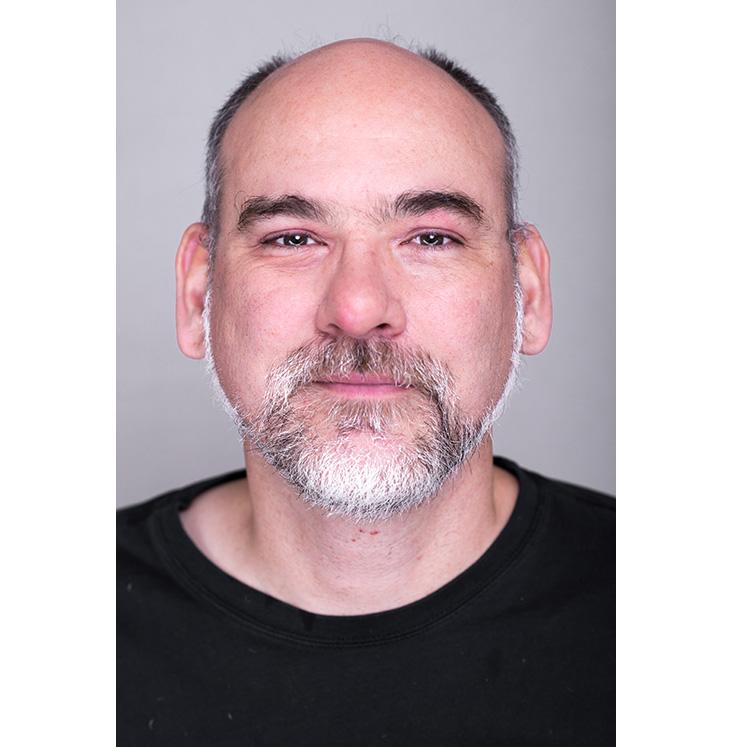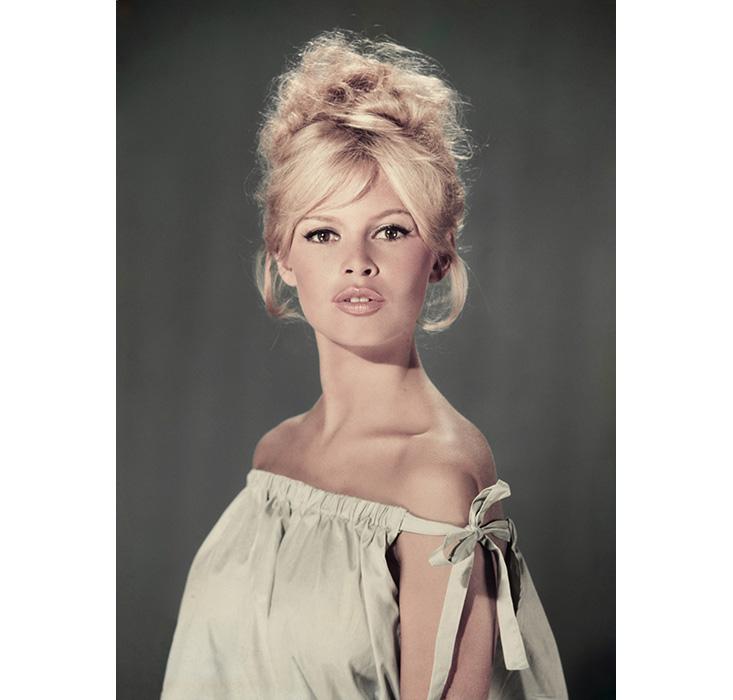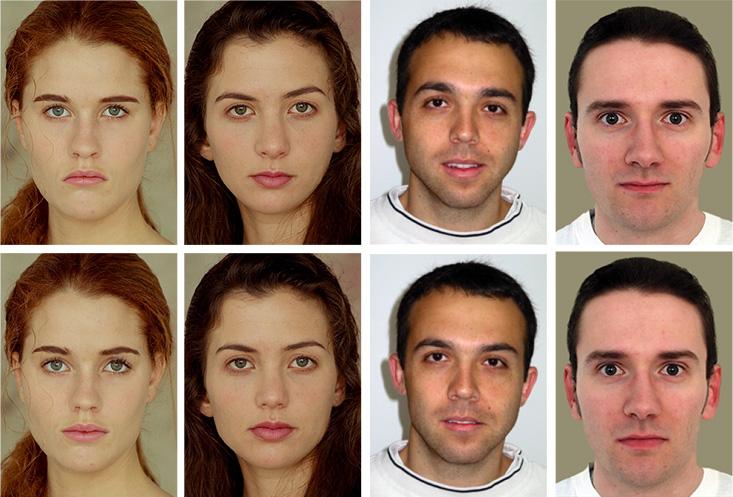Certainly my face isn’t for everyone. My bulbous nose drifts to the right, and my chin is a bit weak, although it’s skillfully hidden behind a goatee. It’s more difficult to hide the bags under my eyes or the fact I have lost most of my hair, which probably kept me from a career in television. And a few months ago, after more than four decades of checking the mirror daily for zits, I noticed that my right ear lobe is shorter than my left. How do you miss something like that?
And yet I judge myself to be not unattractive.1 Is that valid?1 Many researchers have examined the specifics of what we find alluring in another human face. So I decided to use these findings to critically analyze my own mug.
To get started, here is an un-retouched reference shot:

We judge a face within a fraction of a second, just as you have already judged mine. Scientists have tried to quantify universal hotness by showing photos of faces to college students and taking measurements of those consistently identified as handsome or cute. The “politically correct” view, as one research group put it,2 is that beauty is in the eye of the beholder, a stance adopted by many great (and homely) thinkers, including David Hume (“Each mind contemplates a different beauty.”) and Charles Darwin (“It is certainly not true that there is in the mind of man any universal standards of beauty with respect to the human body.”). And yet decades of studies have put this notion to rest: No matter what our race, sexual orientation, social class, age, or gender, we generally agree on which faces are more attractive than others.3
One quality that everybody loves in a face is symmetry, and it’s no secret that mine lacks the balance that turns heads. (The uneven lobes are the least of my worries.) This idea goes way back: Aristotle defined beauty as including “order and symmetry and definiteness.” Scientists believe symmetry signals strong genes. Apparently we all instantly consider “developmental precision” when deciding which faces stand out in the crowd, even if we have no practical—or realistic—plans to reproduce with their owners.
There is no hard-and-fast line that separates beauty from ugliness.
Fortunately for the slightly unbalanced, we also gravitate toward faces whose measurements are closest to the mathematical average. In a classic 1990 study, volunteers looked at composite faces whose features were averaged from many other faces—average nose, average eyes, etc. The more faces that were added to the composites, the more attractive the volunteers found them to be.4 The hypothesis is that we evolved to look for averageness in potential mates (a tendency known as koinophilia) because extremes suggest mutations.5 We may therefore judge a supermodel’s face as especially pleasing, not because her features stand out, but because her visage is extremely typical—a prototype.
Other scientists argue that while average is attractive, it’s not the most attractive. That distinction belongs to humans who have slightly exaggerated average features, a blessed state known as “supernormal.” Brigitte Bardot’s plump lips qualify, as do Angelina Jolie’s ski-slope cheekbones. (I checked, but my generous nose and supersized ears are bugs, not features.) Nancy Etcoff, an evolutionary psychologist at Harvard Medical School and author of Survival of the Prettiest, has argued that women use cosmetics to mimic such supernormal features.6 Therein may lie the difference between “beautiful” and “strikingly beautiful.”
Keep in mind, too, that while studies have revealed general “standards” of beauty—large eyes and a small nose in women, a square jaw and thick eyebrows in men—there is no absolute “face formula.” “We know when we’ve crossed the threshold, but there is no hard-and-fast line that separates beauty from ugliness,” cautions psychologist Michael Cunningham, a professor of communication at the University of Louisville, who in 1986 coined the term “facialmetrics.” Bardot is a case in point. Technically, her lips are “too large,” but no sane man would call her ugly.

So where does that leave me? For perspective, I turned to Tommer Leyvand, one of a team of Israeli scientists who developed software for “digital face beautification.” Leyvand, who is now a director of engineering at (appropriately) Facebook, agreed to beautify me, assuming (as anyone would) that it’s even possible to make me better looking. When Leyvand ran the actor James Franco’s face through the beautification process for The New York Times, for example, nothing happened. Conversely, it deflated Bardot’s lips, which made her more scientifically attractive, but far less striking.
To create the software, Leyvand’s team used research done by another group, in which 68 men and women, ages 25 to 40, from Israel and Germany, selected the most attractive of 92 female and 33 male faces. From those winning portraits, Leyvand and his colleagues measured 84 points on each face (outlining, for example, the eyebrows, eyes, lips, nose, and facial boundary) to create an artificial intelligence that consistently rated attractiveness similarly to the average human rater. During beautification, the algorithm considers 234 edges based on those measurements and makes adjustments accordingly.7
However, the researchers wanted to ensure their program didn’t change a person’s face so much that it was no longer recognizable. (With enough Photoshopping—or plastic surgery—just about anyone can probably be made to resemble a Hollywood star.) So the software moves your facial features in small increments toward the “beauty-weighted average” of the “nearest neighbors of that face”—pretty people whose features look sort of like yours—rather than lurching toward some universal ideal. This was reassuring: I’m not fooling anyone with a Facebook profile shot that looks like Brad Pitt.

Before I reveal the new-and-scientifically-improved me, let’s take a moment to consider a few mitigating factors that may work in my favor (or not). Leyvand’s software doesn’t address non-geometric features such as hair color (men like blondes best; women like redheads least), skin texture (smooth skin signals you don’t have parasites), or a winning smile. So even if my nose-to-eyes-to-lips-to-cheekbone ratios are outliers, I can still explain how I managed to reproduce.
First, the beard. Does the beard help? Scientifically, the jury is out. On the one hand, although in my case it’s old-man white, there’s no better signal of testosterone than facial hair. On the other hand, one study found that the average attractiveness of a group of men’s faces drops when more of them have beards.8 Other research suggests that stubble is more attractive than a heavy beard, and that clean-shaven may trump both.9 So aside from going baby-faced, my best option seems to be to keep up a good trim, and try to always be the only bearded guy in the room.
If you could get a good whiff of my perspiration, and you are a heterosexual woman, you may well find me hotter.
Next: baldness. I probably would have scored better in your eye, oh beholder, if I had shaved my head before the photo shoot, but I wanted this to be realistic. Clearly, male-pattern baldness holds no advantage. The ideal is a full head of hair, but if a man can’t have that, a completely shaved head makes him appear dominant, taller, and stronger. Albert Mannes, a data scientist formerly at The Wharton School, of the University of Pennsylvania, suggests this perception could be due to an association with the military, police, firefighters, or professional athletes. Or it may be that men who shave their heads are judged to have lots of confidence because they live outside the norm.10
Then there’s the magic of B.O. If you could get a good whiff of my perspiration, and you are a heterosexual woman (and you didn’t call the police when I suggest you sniff my underarm “for science”), you may well find me hotter on fourth glance. Studies suggest that women can sniff out men who have different (but not radically different) genetic makeups to their own.11 Women are more attracted to these men probably because they offer the best chances for healthy offspring. The exception to the rule are women who are taking oral contraceptives, which appears to make them prefer men who share similar genes (they may be with the “wrong” guy, but at least they don’t reproduce).
And finally, the X factor. Some researchers argue that we choose partners whose faces resemble our own (“positive assortative mating”) and have the same level of attractiveness that we do (the “matching hypothesis”).12 Biologically, we may not be interested in too-wild experiments in our kids, so we look for people whose features mirror our own. In this case, if you’re a straight woman and don’t find me attractive, it means you can do better—although perhaps not on charm.
So here goes, I’m ready. My face, beautified by Leyvand’s software:
Okay, so obviously I’m no James Franco. Leyvand sent me a drawing on graph paper showing the changes that had been made, some of which I’d expected: a narrower face, raised eyebrows and eyes, more space above my upper lip, a trimmer nose shifted slightly to the right. (“Your nose did need to be smaller,” said my wife.)
I could live with this new face—it’s more East Coast than Midwest, more open to adventure, more confident at the clubs. Although to be honest, pretty boy looks a little emaciated. And it’s not like I was unhappy with the old visage. Actually I was, but only when I was much younger and wished I was better looking so the women I loved would love me back. This concerns me far less as I approach 50, married, my testosterone dropping, and three children to carry forward my DNA. Whatever looks I managed as a younger man that weren’t extinguished by corduroy and the physique of a twig have served me well enough.
My reaction is not unusual, Leyvand says. Research subjects find their new looks interesting, but no one has openly pined for what might have been. And although most volunteers in a controlled experiment predictably rated the “beautified” faces as more attractive, some still preferred the originals, particularly if the subject was someone they already knew, such as a friend or celebrity.
Which makes me wonder if I am being too cynical. Perhaps there is reason to have faith in the eye of the beholder, as Hume and Darwin suggested. Because in the end, no matter what a bunch of faceless, tweedy scientists conclude about your objective attractiveness to other Homo sapiens, your mother will always be there to remind you how handsome or beautiful you are. Right, mom? … Mom? …2
Chip Rowe is a writer based in New York.
References
1. Epley, N. & Whitchurch, E. Mirror, mirror on the wall: Enhancement in self-recognition. Personality and Social Psychology Bulletin 34, 1159-1170 (2008).
2. Little. A.C., Jones, B.C., & DeBruine, L.M. Facial attractiveness: evolutionary based research. Philosophical Transactions of the Royal Society B 366, 1638-1659 (2011).
3. Jones, D. Physical Attractiveness and the Theory of Sexual Selection: Results from Five Populations University of Michigan Press, Ann Arbor, MI (1996).
4. Langlois, J.H. & Roggman, L.A. Attractive faces are only average. Psychological Science 1, 115–121 (1990).
5. Koeslag, J.H. Koinophilia groups sexual creatures into species, promotes stasis, and stabilizes social behaviour. Journal of Theoretical Biology 144, 15-35 (1990).
6. Etcoff, N.L., Stock, S., Haley, L.E., Vickery, S.A., & House, D.M. Cosmetics as a feature of the extended human phenotype: modulation of the perception of biologically important facial signals. PloS One 6 e25656 (2011).
7. Leyvand, T., Cohen-Or, D., Dror, G., & Lischinski. D. Data-driven enhancement of facial attractiveness. ACM Transactions on Graphics 27 (2008). Retrieved from doi: 10.1145/1360612.1360637
8. Janif, Z.J., Brooks, R.C., & Dixson, B.J. Negative frequency-dependent preferences and variation in male facial hair. Biology Letters 10 (2014). Retrieved from doi: 10.1098/rsbl.2013.0958
9. Dixson, B.J. & Brooks, R.C. The role of facial hair in women’s perceptions of men’s attractiveness, health, masculinity and parenting abilities. Evolution & Human Behavior 34, 236-241 (2013).
10. Mannes, A.E. Shorn scalps and perceptions of male dominance. Social Psychological & Personality Science 4, 198-205 (2013).
11. Jacob, S., McClintock, M.K., Zelano, B., & Ober, C. Paternally inherited HLA alleles are associated with women’s choice of male odor. Nature Genetics 30, 175-179 (2002).
12. Alvarez, L. & Jaffe, K. Narcissism guides mate selection: Humans mate assortatively, as revealed by facial resemblance, following an algorithm of “self seeking like.” Evolutionary Psychology 2, 177-194 (2004).



























